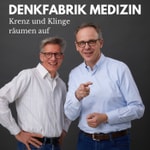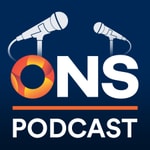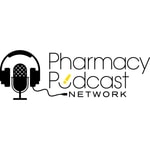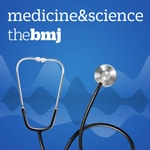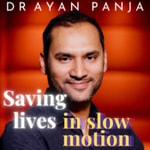Drug Safety Matters – Détails, épisodes et analyse
Détails du podcast
Informations techniques et générales issues du flux RSS du podcast.

Drug Safety Matters
Uppsala Monitoring Centre
Fréquence : 1 épisode/36j. Total Éps: 51

Drug Safety Matters brings you the best stories from the world of pharmacovigilance. Through in-depth interviews with our guests, we cover new research and trends, and explore the most pressing issues in medicines safety today. Produced by Uppsala Monitoring Centre, the WHO Collaborating Centre for International Drug Monitoring.
Classements récents
Dernières positions dans les classements Apple Podcasts et Spotify.
Apple Podcasts
🇫🇷 France - medicine
04/01/2025#92🇫🇷 France - medicine
03/01/2025#64🇫🇷 France - medicine
04/10/2024#82
Spotify
Aucun classement récent disponible
Liens partagés entre épisodes et podcasts
Liens présents dans les descriptions d'épisodes et autres podcasts les utilisant également.
See all- https://www.who-umc.org/
52 partages
- https://www.uppsalareports.org/
16 partages
- https://uppsalareports.org/Subscribe
10 partages
- https://www.linkedin.com/company/109057/
51 partages
Qualité et score du flux RSS
Évaluation technique de la qualité et de la structure du flux RSS.
See allScore global : 48%
Historique des publications
Répartition mensuelle des publications d'épisodes au fil des années.
#31 A guide to reporting disproportionality analyses – Michele Fusaroli and Daniele Sartori
lundi 30 septembre 2024 • Durée 42:45
Disproportionality analyses are a mainstay of pharmacovigilance research, but without clear guidelines, they often lead to confusion and misinterpretation. Enter the READUS-PV statement: the first-ever guide for reporting disproportionality analyses that are replicable, reliable, and reproducible.
Tune in to find out:
- The history of reporting guidelines in pharmacovigilance and why the READUS-PV guidelines were created
- Why there has been a spike in the publication of disproportionality analyses in recent years and what this means for their reliability
- What it means to publish “good” pharmacovigilance science
Want to know more?
- Read the READUS-PV guidelines, why they were created, and why they are important.
- In 2021, Khouri and colleagues showed that current methods and models used for disproportionality analyses are unreliable, and Mouffak and colleagues found that there is a tendency to overstate results in published disproportionality analyses.
- A book on data mining techniques in Pharmacovigilance by Poluzzi and colleagues delves deeper into this exponential increase in disproportionality analyses.
- This paper elaborates on the Delphi technique, and how it is used to gather data from reviewers to achieve scientific consensus on a problem.
Join the conversation on social media
Follow us on X, LinkedIn, or Facebook and share your thoughts about the show with the hashtag #DrugSafetyMatters.
Got a story to share?
We’re always looking for new content and interesting people to interview. If you have a great idea for a show, get in touch!
About UMC
Read more about Uppsala Monitoring Centre and how we work to advance medicines safety.
Uppsala Reports Long Reads – Weeding out duplicates to better detect side effects
lundi 26 août 2024 • Durée 25:02
Duplicate reports are a big problem when it comes to signal detection, but with the help of machine learning and new ways of comparing reports, we may more effectively detect them.
This episode is part of the Uppsala Reports Long Reads series – the most topical stories from UMC’s pharmacovigilance news site, brought to you in audio format. Find the original article here.
After the read, we speak to author Jim Barrett, Senior Data Scientist at UMC, to learn more about the duplicate detection algorithm and UMC’s work to develop AI resources for pharmacovigilance.
Tune in to find out:
- How the new algorithm handles duplicates in VigiBase
- About different approaches for developing algorithms
- Why it can be challenging to evaluate the performance of an algorithm
Want to know more?
- Listen to the Drug Safety Matters interview with Michael Glaser about his Uppsala Reports article “Ensuring trust in AI/ML when used in pharmacovigilance” and check out the episode’s extensive list of links for more on AI in pharmacovigilance.
- Artificial intelligence in pharmacovigilance – value proposition and the need for critical appraisal, a presentation by Niklas Norén, Head of Research at UMC, given at University of Verona in April 2024.
Finally, don’t forget to subscribe to the monthly Uppsala Reports newsletter for free regular updates from the world of pharmacovigilance.
Join the conversation on social media
Follow us on X, LinkedIn, or Facebook and share your thoughts about the show with the hashtag #DrugSafetyMatters.
Got a story to share?
We’re always looking for new content and interesting people to interview. If you have a great idea for a show, get in touch!
About UMC
Read more about Uppsala Monitoring Centre and how we work to advance medicines safety.
Uppsala Reports Long Reads – The colour of signals
vendredi 29 septembre 2023 • Durée 33:59
Herbal remedies have been used for thousands of years to treat what ails us. Yet why do we still know so little about their potential side effects compared to modern medicines?
This episode is part of the Uppsala Reports Long Reads series – the most topical stories from UMC’s pharmacovigilance news site, brought to you in audio format. Find the original article here.
After the read, we speak to author Daniele Sartori to learn more about the challenges in herbal pharmacovigilance.
Tune in to find out:
- Why the risks of herbals are rarely discussed
- How to encourage safety data collection for herbals
- How to improve herbal nomenclature and regulation
Want to know more?
Here are some of the resources cited in the episode:
- Underreporting of adverse reactions to herbal remedies is driven by our attitude towards herbals themselves, but also by a lack of training on herbal medicines in healthcare curricula.
- It is possible to safely use herbal medicines together with other medicines, but we must keep in mind some critical issues related to their interaction.
- Simple videos can dramatically increase public awareness of ADR reporting schemes.
- Kew Gardens’ Medicinal Plant Names Services offers a systematic overview of medicinal plants and their accepted scientific names.
- The American Botanical Council suggests methods to uncover attempts to adulterate plant extracts.
For a comprehensive overview of herbal pharmacovigilance, check out this recent book by Joanne Barnes and colleagues covering advances, challenges, and international perspectives in the field.
For more on Daniele’s scoping review of signals or the thorny nomenclature of medicinal plants, listen to these episodes from the Drug Safety Matters archive:
Finally, don’t forget to subscribe to the monthly Uppsala Reports newsletter for free regular updates from the world of pharmacovigilance.
Join the conversation on social media
Follow us on X, LinkedIn, or Facebook and share your thoughts about the show with the hashtag #DrugSafetyMatters.
Got a story to share?
We’re always looking for new content and interesting people to interview. If you have a great idea for a show, get in touch!
About UMC
Read more about Uppsala Monitoring Centre and how we work to advance medicines safety.
Uppsala Reports Long Reads – Empowering patients as partners
mardi 5 septembre 2023 • Durée 42:43
A patient's perspective can ensure safe medical care and lead to new insights that traditional research may overlook. But how do we best harness that perspective to improve patient outcomes?
This episode is part of the Uppsala Reports Long Reads series – the most topical stories from UMC’s pharmacovigilance news site, brought to you in audio format. Find the original article here.
After the read, we speak to Manal Younus, who authored the article, to learn more about patient engagement and its benefits for medicines safety.
Tune in to find out:
- How regulators and healthcare professionals can effectively engage patients
- How patients can get involved in drug safety monitoring
- What the pharmacovigilance community learned from the valproate case
Want to know more?
In 2022, the Council for International Organizations of Medical Sciences (CIOMS) published a comprehensive report on patient involvement in the development, regulation and safe use of medicines. They also recorded a webinar to summarise the report’s main conclusions.
The International Society of Pharmacovigilance (ISoP) runs a patient engagement group to advance patient involvement in the safety monitoring of medicines.
The Valproate toolkit, developed by the UK’s Medicines and Healthcare Products Regulatory Agency (MHRA), supports healthcare professionals in advising women of childbearing age about the risks and benefits of valproate therapy.
PatientsLikeMe is a digital platform where patients can share personal health stories, connect to peers, and learn about different conditions and treatments.
For more on patient engagement and communication, check out these episodes from the Drug Safety Matters archive:
Finally, don’t forget to subscribe to the monthly Uppsala Reports newsletter for free regular updates from the world of pharmacovigilance.
Join the conversation on social media
Follow us on X, LinkedIn, or Facebook and share your thoughts about the show with the hashtag #DrugSafetyMatters.
Got a story to share?
We’re always looking for new content and interesting people to interview. If you have a great idea for a show, get in touch!
About UMC
Read more about Uppsala Monitoring Centre and how we work to advance medicines safety.
#23 Assessing safety in clinical trials – Marianne Lunzer & Sanja Prpić
mardi 27 juin 2023 • Durée 31:06
Medicines safety monitoring is a continuous process that begins with pre-marketing clinical trials and continues with post-marketing studies to fill any gaps in knowledge. With Marianne Lunzer from AGES and Sanja Prpić from HALMED, we review the pros and cons of various study types and the importance of testing medicines on diverse populations.
Tune in to find out:
- How pre- and post-approval safety studies are connected
- Why safety assessors can request studies in underrepresented populations
- How new regulations are impacting safety assessments in the EU
Want to know more?
This review in Trials summarises the methodological challenges of assessing drug safety in clinical trials, while this study in Clinical and Translational Science reviews how sex, racial, and ethnic diversity in clinical trials have changed in recent years.
Post-authorisation safety studies can be imposed or voluntary and can be carried out as clinical trials or as non-interventional studies. Read about the differences on the European Medicines Agency’s website.
Large simple trials can control for biases in observational research while still providing results that are generalisable to real-world use. This review in Drug Safety explains why.
The new Clinical Trials Regulation harmonises how EU trials are assessed and supervised for increased safety and transparency. As part of these efforts, the SAFE CT project aims to facilitate clinical trial coordination and safety assessments in the EU.
For more on clinical trials, revisit this conversation with Peter Doshi on restoring invisible and abandoned trials.
This episode is the last of a three-part series on sources of evidence in pharmacovigilance. Listen to the first two episodes here:
Join the conversation on social media
Follow us on X, LinkedIn, or Facebook and share your thoughts about the show with the hashtag #DrugSafetyMatters.
Got a story to share?
We’re always looking for new content and interesting people to interview. If you have a great idea for a show, get in touch!
About UMC
Read more about Uppsala Monitoring Centre and how we work to advance medicines safety.
#22 Reforming pharmacovigilance education – Michael Reumerman
lundi 8 mai 2023 • Durée 32:54
Healthcare professionals are key players in medicines safety but they often lack the time or knowledge to report adverse drug reactions. To change that, we need to urgently rethink how we teach pharmacovigilance, argues Michael Reumerman from Amsterdam University Medical Centers.
Tune in to find out:
- How real-life education can benefit healthcare students
- Which educational intervention can be most impactful
- How adverse drug event managers can improve pharmacovigilance
Want to know more?
In his PhD thesis, Michael details the current state of pharmacovigilance education and all the real-life interventions he and his colleagues have tested in the Netherlands so far.
As part of an international collaboration, staff at Amsterdam UMC have helped set up the European Open Platform for Prescribing Education (EurOP2E), an online collection of problem-based, open teaching resources to improve clinical pharmacology and therapeutics education.
The World Health Organization’s Guide to Good Prescribing provides a six-step guide for students to the process of rational prescribing – but the time has come to update both its content and form.
In 2018, the Netherlands Pharmacovigilance Centre Lareb developed a core curriculum for pharmacovigilance education in universities.
Whether you’re a healthcare professional or not, check out Uppsala Monitoring Centre’s growing collection of self-paced e-learning courses to learn about different aspects of pharmacovigilance.
Join the conversation on social media
Follow us on X, LinkedIn, or Facebook and share your thoughts about the show with the hashtag #DrugSafetyMatters.
Got a story to share?
We’re always looking for new content and interesting people to interview. If you have a great idea for a show, get in touch!
About UMC
Read more about Uppsala Monitoring Centre and how we work to advance medicines safety.
#21 Unlocking the power of real-world data – Patrick Ryan
jeudi 30 mars 2023 • Durée 33:42
The vast amount of real-world data collected during routine clinical care is a treasure trove of safety information – but there are challenges to overcome before this rich source of evidence can be applied to pharmacovigilance. Patrick Ryan from Johnson & Johnson discusses how to harness real-world data for patient safety.
Tune in to find out:
- How real-world data is collected and analysed
- Which pharmacovigilance processes will benefit most from it
- How to make data accessible without infringing patient privacy
Want to know more?
Review the basics of real-world data and its use in the medicines life cycle in Pharmaceutical Medicine, or read up on the opportunities and challenges for pharmacovigilance in Clinical Pharmacology & Therapeutics.
In partnership with the Observational Health Data Sciences and Informatics (OHDSI) and the European Health Data & Evidence Network (EHDEN) consortia, UMC researchers are exploring how real-world data can help prioritise and validate signals in pharmacovigilance. Read about their latest collaboration on Uppsala Reports.
Another important player in the real-world data space is the Data Analysis and Real World Interrogation Network (DARWIN), which aims to provide timely and reliable evidence from real-world healthcare databases in the EU to improve the safety and effectiveness of medicines.
For more on real-world evidence and the challenges of working with big data, don’t miss the Voice of EHDEN podcast or this conversation with Elena Rocca from the Drug Safety Matters archive.
This episode is the second of a three-part series on sources of evidence in pharmacovigilance. Listen to the other two episodes here:
Join the conversation on social media
Follow us on X, LinkedIn, or Facebook and share your thoughts about the show with the hashtag #DrugSafetyMatters.
Got a story to share?
We’re always looking for new content and interesting people to interview. If you have a great idea for a show, get in touch!
About UMC
Read more about Uppsala Monitoring Centre and how we work to advance medicines safety.
#20 The evidence for signals – Daniele Sartori
jeudi 23 février 2023 • Durée 45:41
Spontaneous reports of adverse drug reactions are a common source of evidence in pharmacovigilance, but as the science evolves, so do the types of data used to find and assess signals. Uppsala Monitoring Centre’s Daniele Sartori reviews how signal detection practices have changed over time.
Tune in to find out:
- Which features of case reports are most often used to assess causality
- Why pharmacovigilance experts should report clinical assessments clearly
- How to shorten the time between signal detection and communication
Want to know more?
Check out the full scoping review that inspired this episode.
In 2002, Meyboom and colleagues discussed criteria to select and follow up on signals.
In the first chapter of Uncertainty in Pharmacology, Aronson explains the difference between evidence for a mechanism and evidence from a mechanism.
In 2018, Murad and colleagues published a method to evaluate the quality of evidence in a series of case reports.
UMC scientists have shown how chemical information can support timely signal detection.
This episode is the first of a three-part series on sources of evidence in pharmacovigilance. Listen to the other two episodes here:
Join the conversation on social media
Follow us on X, LinkedIn, or Facebook and share your thoughts about the show with the hashtag #DrugSafetyMatters.
Got a story to share?
We’re always looking for new content and interesting people to interview. If you have a great idea for a show, get in touch!
About UMC
Read more about Uppsala Monitoring Centre and how we work to advance medicines safety.
Uppsala Reports Long Reads – Unmasking data in the COVID-19 vaccine era
jeudi 26 janvier 2023 • Durée 21:19
Most pharmacovigilance professionals will have heard of masking – a statistical issue where reports for one drug hide signals for other drugs. But the problem gained fresh attention when record amounts of reports began piling up for the COVID-19 vaccines. How should we be unmasking data in the COVID-19 vaccine era?
This episode is part of the Uppsala Reports Long Reads series – the most topical stories from UMC’s pharmacovigilance magazine, brought to you in audio format. Find the original article here.
After the read, we speak to data scientist Sara Vidlin, who authored the article, to learn more about masking and how to deal with it.
Tune in to find out:
- How masking evolves with the data
- Which methods can be used to unmask data
- What other pitfalls to watch out for when performing quantitative analyses
Want to know more?
In the very beginning of the vaccine rollout, the USA FDA observed how early signals for COVID-19 vaccines were delayed because of other drugs masking them, highlighting how masking is not a static phenomenon.
In 2013, Uppsala Monitoring Centre developed a simple strategy to uncover masking by identifying and removing influential outliers.
Join the conversation on social media
Follow us on X, LinkedIn, or Facebook and share your thoughts about the show with the hashtag #DrugSafetyMatters.
Got a story to share?
We’re always looking for new content and interesting people to interview. If you have a great idea for a show, get in touch!
About UMC
Read more about Uppsala Monitoring Centre and how we work to advance medicines safety.
#19 Lessons in pandemic pharmacovigilance – Elena Rocca
jeudi 15 décembre 2022 • Durée 33:11
The COVID-19 pandemic forced pharmacovigilance experts to revisit their processes to deal with unprecedented volumes of data and catch unexpected safety issues. Elena Rocca from Oslo Metropolitan University reviews the challenges of a global healthcare emergency – and what it can teach us about the science of drug safety.
Tune in to find out:
- How to handle uncertain evidence
- Why clinical expertise matters in the age of big data
- Why pharmacovigilance requires interdisciplinary thinking
Want to know more?
In the article that inspired this episode, Elena Rocca and Birgitta Grundmark describe the practical, conceptual, and ethical challenges pharmacovigilance experts were faced with during the pandemic.
See also this review by Annette Rudolph and colleagues at Uppsala Monitoring Centre on the unique challenges of a global vaccination campaign.
Elena’s reflections on big data pharmacovigilance and its ethical implications were inspired by Sabina Leonelli’s work on big data biology and mathematician Cathy O’Neil’s Weapons of Math Destruction.
The CauseHealth Pharmacovigilance project, a collaboration between UMC and the NMBU Centre for Applied Philosophy of Science in Norway, ran between 2018 and 2021.
For more philosophical inspiration, revisit this interview with Eugene van Puijenbroek on intuition in pharmacovigilance or this Uppsala Reports Long Read on new approaches to causality.
Join the conversation on social media
Follow us on X, LinkedIn, or Facebook and share your thoughts about the show with the hashtag #DrugSafetyMatters.
Got a story to share?
We’re always looking for new content and interesting people to interview. If you have a great idea for a show, get in touch!
About UMC
Read more about Uppsala Monitoring Centre and how we work to advance medicines safety.



